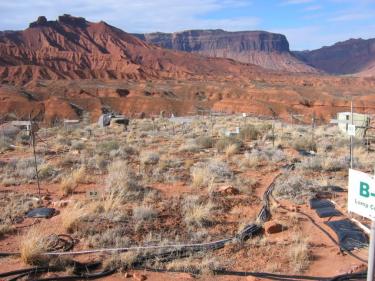CU alumni compare experimental climate change to human trampling on biocrusts, with disturbing results.
The potential effects of climate change are just as bad as human trampling for biological soil crust communities, two University of Colorado Boulder alumni have found.
The findings were published this fall in the prestigious Proceedings of the National Academy of Sciences by CU-Boulder alumni and U.S. Geological Survey researchers Scott Ferrenberg (EEB ’14) and Sasha Reed (EEB ’08).
One of the longest-running studies of its kind, Ferrenberg and Reed’s 15-year study in Moab, Utah, compared the effects of foot traffic to the expected impacts of climate change on biological soil crust communities on the semiarid Colorado Plateau.
Scott Ferrenberg, who earned his Ph.D. in biology from CU-Boulder, is shown near Moab, Utah, where he and CU alumna Sasha Reed conducted a groundbreaking study on biocrust. Photo courtesy of Scott Ferrenberg.
Soil crusts are made of cyanobacteria, more commonly known as algae. Mosses and lichens are part of the biological soil crust community as well. These crusts glue the soil together through complex sugars.
Vital for soil fertility and stability, biocrusts are threatened by physical impact from foot and vehicle traffic. Physical destruction of biocrusts kills the lichens and mosses, which then harms soil fertility, and increases dust storms and health hazards. These effects have been well documented by ecologists around the world.
Ferrenberg and Reed compared the effects of physical pressure to the potential effects of climate change by exerting physical force on a control plot and subjecting other plots to experimental climate change. They continually warmed five plots of land a few degrees above the surrounding area, increased the frequency of watering on another five plots, and then both artificially warmed and watered a third set of plots.
By simulating the projections for climate change in the American Southwest, Ferrenberg and Reed hoped to learn what is in store for the semiarid landscapes of Colorado and Utah, and what the global implications of climate change might be.
As expected, the lichens and mosses that endured human trampling in the control plots were immediately damaged, but “what was sad and shocking to us was that giving water and warming had the same effect as physical pressure,” says Ferrenberg.
Effects of increased precipitation
In accordance with water predictions for the future of the Southwest, Ferrenberg and Reed increased the frequency of small rainfall events for one set of plots, meaning they frequently gave them small amounts of water, “just enough to get the surface noticeably wet,” Ferrenberg says.
They hypothesized that the extra water would either benefit or not change the biocrusts much.
“You’d think giving water to stuff in the desert would be good, but it wasn’t,” Ferrenberg says.
In fact, it ultimately destroyed the mosses and even the lichens in the first year of the experiment.
“These organisms have adapted to the pulses of moisture…Because it’s [normally] such a rare event to get moisture, the crusts will become active with any amount of water,” Ferrenberg says. “These plants have no vascular system, so as soon as [the mosses] get wet, they start photosynthesizing.”
Unlike regular plants, biocrust plants can photosynthesize only when wet, and they have evolved to become extremely active to take advantage of the limited rainfall in the desert.
“Biocrust organisms have been so successful because they become active really quickly,” Reed says.
With frequent, small rainfall events, though, this trait becomes negative.
When there isn’t enough water to complete photosynthesis, mosses put out too much energy without getting any back. Forced to endure too many small rainfall events, these crusts ultimately starve themselves.
There are studies from a number of other countries, as well as the work here in the United States, to suggest future problems for the survival of these crusts in the face of climate change."
“Pretend you’re a moss and you get wet and immediately gear up to photosynthesize,” Reed says. “It costs you energy; you’re eating through carbon.”
The physiological mechanism that helps them survive in the desert drove them into carbon starvation—in which water-starved plants stop photosynthesizing—within one year of the small rainfall event treatment.
“They are able to cope with the demands of photosynthesis once or twice, but not over and over,” Ferrenberg says.
If the climate projections for precipitation in the Southwest are correct, mosses’ and lichens’ ability to survive will actually kill them, leaving a less-complex biocrust to stabilize and fertilize soil.
Effects of increased temperature
Using infrared heating lamps suspended over the surface, Ferrenberg and Reed warmed another set of plots a few degrees higher than the surrounding land. This mimicked the increased temperatures projected 100 years from now.
“Increased temperatures caused a slow, but inevitable decline after about six or seven years,” Ferrenberg says.
Reed says they are not yet sure of the physiological mechanism that caused the mosses to respond so badly to the increase in heat, but she says it likely has to do with increased stress.
The fourth set of plots received watering and warming treatments together.
Reed says this was bad for mosses, but was “by far the worst for the lichens.”
Impacts of degraded soil crusts
While physical destruction has an immediate, devastating impact on biocrusts, it is preventable, in that it is possible to keep people off biocrusts.
Stopping climate change is another matter.
“We can’t stop warming at this time, so we’re going to see a degradation of crust,” Ferrenberg says.
The effects of climate change, then, will create less stable soil. This increasingly eroded soil ends up in river ways and disturbs dust that is then exported internationally.
This is problematic for the western United States, which has many deserts and biocrusts, but the problem doesn’t end there. Biocrust is a main component of dryland ecosystems, which make up 40 percent of the earth’s land surface.
Ferrenberg and Reed represent just one group trying to determine how universal these effects will be.
“There are studies from a number of other countries, as well as the work here in the United States, to suggest future problems for the survival of these crusts in the face of climate change,” Reed says.
One big question they’re trying to address is whether biocrusts in hot deserts, like the Chihuahuan desert in southern New Mexico, are different from those in ‘cold deserts’ like the Colorado Plateau in Moab.
“For example, one hypothesis could be that hot desert crusts are less vulnerable to the type of climate change we expect, and thus…cold deserts around the world…could face a bigger problem,” Reed says.
Lara Herrington Watson is a CU alumna (’07) and freelance writer who splits her time between Denver and Phoenix.






